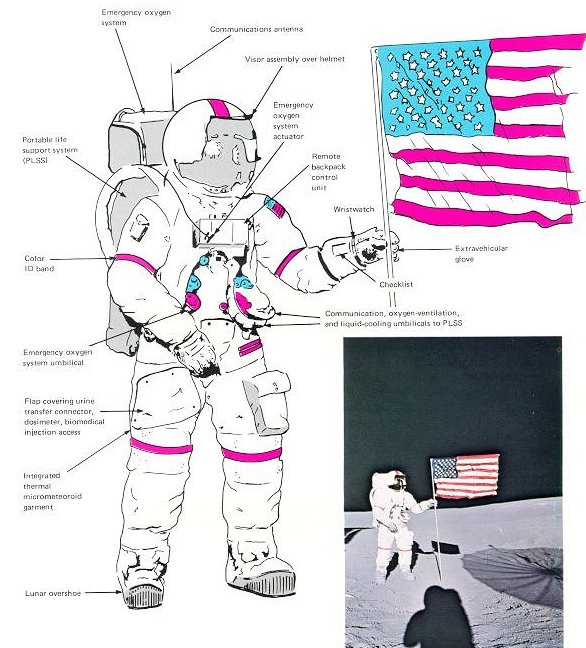
Protecting Men for Their Steps on the Moon
The lunar environment is hostile to man. It lacks oxygen and water; it is too hot in the day's sunshine (250° F) and too cold in the night's darkness (-250° F). Hazardous micrometeoroids and space radiation dart about. With no atmosphere and therefore no atmospheric pressure, fluids in an exposed human body will boil on the Moon. How can man survive, much less operate, in such an unfriendly environment? Answer: by taking his own friendly environment with him in the form of a spacesuit.

|
The spacesuit, or Extravehicular Mobility Unit (EMU), shown above, is actually three suits in one. These three may roughly be described as: a union suit, a diver's suit, and a suit of armor. Each is custom-tailored to an astronaut's dimensions. Precise models of astronaut's hands, for example, shown below, were used to prepare fitted gloves.

|
The union suit is climbed into first. Made up of a network of flexible tubes embedded in a mesh fabric, this water-cooled underwear is linked to the vital backpack portable life support system (PLSS) where the water and oxygen are stored and metered for precise circulation. The cooling is necessary because body heat cannot dissipate adequately.
Over this liquid cooling garment the Astronaut wears the pressure garment assembly, a kind of super-sophisticated diver's suit. Constructed of rubbers and fabrics, and with cleverly contrived joints, this assembly retains the oxygen atmosphere without leakage while facilitating movement. It too is linked into the PLSS, where carbon dioxide and other contaminants are removed from the oxygen stream. A chest-mounted remote control unit permits the astronaut to adjust oxygen flow and cooling temperature to match his preferences. The PLSS will sustain activity for up to 8 hours before its oxygen, water, and battery power must be recharged. A separate oxygen system, atop the PLSS, is available for emergencies; up to 75 minutes' worth of oxygen is available, depending on the draw-off rate.
Protecting the integrity of the pressure garment is the outer suit of armor, a 13-layer composite more like a coat of mail than the rigid clanking uniform of castle-haunting ghosts. The various layers of the outer garment protect the knight of Apollo from the slings and arrows of outer space: micrometeoroids, ultraviolet rays, and other radiation. Visors and shades similarly protect the eyes.
All suited up the astronaut is not unlike the small boy who has been so bundled up that he can hardly move, much less frolic in the snow. Actually, given all the constraints and requirements, spacesuit designers were highly successful in affording the astronaut extensive mobility in his EMU. Nevertheless, like the knights of old, squires are needed to assist suited astronauts in mounting their steeds and once aboard their spacecraft the astronauts help each other in donning and doffing their outfits. Going to the bathroom, as one would imagine, would be nigh impossible in such garb. So designers built in a sheath urinal and collector bag. Aside from specially absorbent underwear, there was no provision for bowel movements during EVA. (Within the spacecraft, these were coped with by sealable disposable bags.)
A compressed food bar for the astronaut to nibbie on is positioned inside the helmet, as is a straw-like tube for sipping a beverage from a neck-ring suspended bag. Close to the mouth also are voice-actuated microphone pick-ups, which are an integral part of a skull cap worn under the helmet. A backpack-housed communications system enables the astronaut out on the airless Moon to converse with his colleagues in the spacecraft and in Mission Control. The latter also receive, through the PLSS, telemetered biomedical data picked up from sensors on the astronaut.
Astronauts actually had a wardrobe of suits, each oppropriately designed for use in training, flight, surface and free-space EVA, and as backup. Expensive, sartorial splendor was not one of the suit's design criteria; survival plus the abilities to communicate, move about, and deal with equipment were.
| Next |